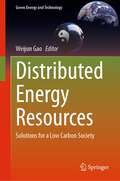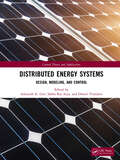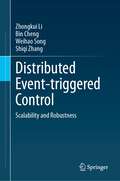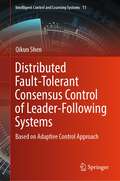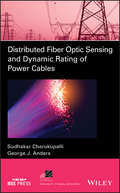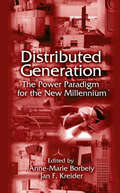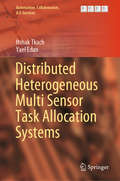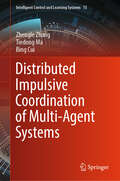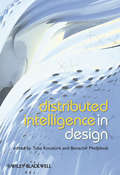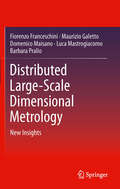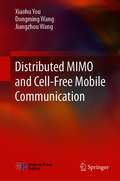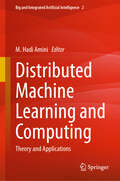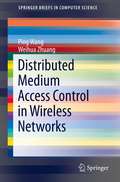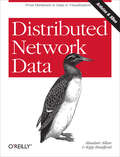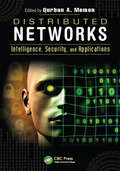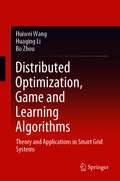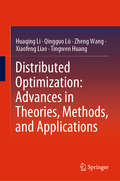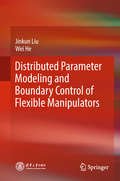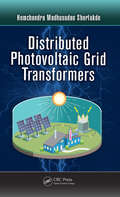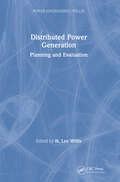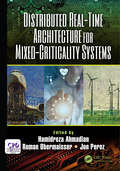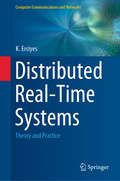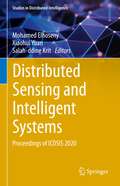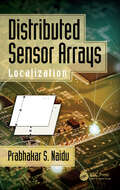- Table View
- List View
Distributed Energy Resources: Solutions for a Low Carbon Society (Green Energy and Technology)
by Weijun GaoThe future of the distributed energy generation market is promising, with opportunities in the residential, commercial, and industrial sectors driven by increasing awareness of clean energy, greenhouse gas (GHG) emission reduction targets, and rising global demand for energy. This book focuses on UN Sustainable Development Goal 7, which aims to "ensure access to affordable, reliable, sustainable, and modern energy for all." It provides research results, applications, and case studies on the potential of distributed energy resources as a solution to building a low-carbon society. Coverage includes modeling and evaluation of distributed power systems, system maintenance and reliability, economic potential and implications of hydrogen energy systems, grid stabilization and carbon emission reduction, smart design, and the impact of energy penetration on public power grids. Case studies include the effects of renewable energy policies on solar photovoltaic energy in China, Germany, Japan, and the United States of America and a feasibility assessment of distributed energy systems in Shanghai. Distributed Energy Resources: Solutions for a Low Carbon Society will be a valuable resource for postgraduate students and researchers in energy systems, urban energy management, and renewable energy technologies and a reference guide for practicing engineers, urban energy planners, and energy system managers.
Distributed Energy Systems: Design, Modeling, and Control (Control Theory and Applications)
by Dmitri Vinnikov Ashutosh K. Giri Sabha Raj AryaThis book provides the insight of various topology and control algorithms used for power control in distributed energy power conversion systems such as solar, wind, and other power sources. It covers traditional and advanced control algorithms of power filtering including modelling and simulations, and hybrid power generation systems. The adaptive control, model predictive control, fuzzy-based controllers, Artificial Intelligence-based control algorithm, and optimization techniques application for estimating the error regulator gains are discussed. Features of this book include the following: Covers the schemes for power quality enhancement, and voltage and frequency control. Provides complete mathematical modelling and simulation results of the various configurations of the renewable energy-based distribution systems. Includes design, control, and experimental results. Discusses mathematical modelling of classical and adaptive control techniques. Explores recent application of control algorithm and power conversion. This book is aimed at researchers, professionals, and graduate students in power electronics, distributed power generation systems, control engineering, Artificial Intelligent-based control algorithms, optimization techniques, and renewable energy systems.
Distributed Event-triggered Control: Scalability and Robustness
by Zhongkui Li Bin Cheng Weihao Song Shiqi ZhangThis book focuses on distributed event-triggered control of multi-agent systems, in which the event-triggering mechanism is utilized to reduce the communication frequencies in order to compensate for constrained network bandwidths, an aspect that poses significant challenges for distributed control design. The book summarizes the authors’ original, systematic contributions on scalability and robustness, two core issues in distributed event-triggered control. Specifically, the book presents fully distributed adaptive event-triggered control laws; as they rely on neither continuous communications nor global information on the network, these laws are scalable with regard to network size and topology. Moreover, the book provides novel and robust event-triggered algorithms, which can accommodate various frequency-domain and matching uncertainties. The results presented here are applicable to UAV swarms, automobile systems, aerospace systems, vehicle platooning, and more, and will be of considerable interest to graduate students, researchers, and engineers working on network control systems.
Distributed Fault-Tolerant Consensus Control of Leader-Following Systems: Based on Adaptive Control Approach (Intelligent Control and Learning Systems #11)
by Qikun ShenThis book provides recent theoretical results and applications of the consensus control for nonlinear leader-following systems. Combining adaptive control technique, fuzzy logic systems, neural networks with the other control techniques or approaches, this book investigates the consensus control problem of leader-following systems and proposes the corresponding control scheme. This book intends to provide the readers a good understanding on consensus control based on adaptive control technology. This book can serve as a reference for the main research issues and results on nonlinear multi-agent systems including leader-following systems for researchers devoting to various areas of control theory, as well as a material for graduate and undergraduate students interested in nonlinear multi-agent systems including leader-following systems and their applications. Some prerequisites for reading this book include nonlinear system theory, matrix theory, mathematics, basic graph theory, and so on.
Distributed Fiber Optic Sensing and Dynamic Rating of Power Cables (IEEE Press Series on Power Engineering)
by Sudhakar Cherukupalli George J. AndersA guide to the physics of Dynamic Temperature Sensing (DTS) measurements including practical information about procedures and applications Distributed Fiber Sensing and Dynamic Ratings of Power Cable offers a comprehensive review of the physics of dynamic temperature sensing measurements (DTS), examines its functioning, and explores possible applications. The expert authors describe the available fiber optic cables, their construction, and methods of installation. The book also includes a discussion on the variety of testing methods with information on the advantages and disadvantages of each. The book reviews the application of the DTS systems in a utility environment, and highlights the possible placement of the fiber optic cable. The authors offer a detailed explanation of the cable ampacity (current rating) calculations and examines how the measured fiber temperature is used to obtain the dynamic cable rating information in real time. In addition, the book details the leading RTTR suppliers, including the verification methods they used before their products come to market. Information on future applications of the DTS technology in other aspects of power system operation is also discussed. This important book: • Explains the required calibration procedures and utility performance tests needed after the installation of a DTS system • Includes information on the various practical aspects of communicating measured and computed quantities to the transmission system operator • Reviews possible applications of the technology to fault location, vibration monitoring, and general surveying of land and submarine cable routes Written for cable engineers and manufacturers, Distributed Fiber Sensing and Dynamic Ratings of Power Cable is an authoritative guide to the physics of DTS measurements and contains information about costs, installation procedures, maintenance, and various applications.
Distributed Generation: The Power Paradigm for the New Millennium
by Jan F. Kreider Ann-Marie BorbelyAs a result of deregulation, the US electric utility industry is undergoing a dramatic transformation with far-reaching technical and social consequences. At the heart of this transformation lies Distributed Generation (DG)-the substitution of centralized electricity production with smaller-scale technologies located in or near facilities and power
Distributed Heterogeneous Multi Sensor Task Allocation Systems (Automation, Collaboration, & E-Services #7)
by Itshak Tkach Yael EdanToday’s real-world problems and applications in sensory systems and target detection require efficient, comprehensive and fault-tolerant multi-sensor allocation. This book presents the theory and applications of novel methods developed for such sophisticated systems. It discusses the advances in multi-agent systems and AI along with collaborative control theory and tools. Further, it examines the formulation and development of an allocation framework for heterogeneous multi-sensor systems for various real-world problems that require sensors with different performances to allocate multiple tasks, with unknown a priori priorities that arrive at unknown locations at unknown time. It demonstrates how to decide which sensor to allocate to which tasks when and where. Lastly, it explains the reliability and availability issues of task allocation systems, and includes methods for their optimization.The presented methods are explained, measured, and evaluated by extensive simulations, and the results of these simulations are presented in this book. This book is an ideal resource for academics, researchers and graduate students as well as engineers and professionals and is relevant for various applications such as sensor network design, multi-agent systems, task allocation, target detection, and team formation.
Distributed Impulsive Coordination of Multi-Agent Systems (Intelligent Control and Learning Systems #15)
by Zhengle Zhang Tiedong Ma Bing CuiThis book investigates the distributed impulsive coordination control of multi-agent systems (MASs), including consensus problem and formation problem. Compared with continuous control, impulsive control as a discontinuous control method only needs information interaction at impulsive instants, which can greatly reduce the transmission cost in the communication process. In practice, MASs are often affected by environmental and hardware conditions, resulting in the application of impulsive control is limited. For example, it is difficult to exert the impulsive control signal accurately at a fixed instant, and it is difficult to control all agents at the same impulsive instant. Moreover, the actual models of MASs often contain some constraints such as unknown parameters, stochastic perturbation, and time delays. In addition, stochastic switching topologies and cyberattacks will limit the communication between agents in MASs, which will greatly affect the coordination control performance. Based on the existing research results, this book considers the above constraints of MASs in practice and studies the key problems of distributed impulsive coordination control for MASs. The book is intended for undergraduate and graduate students who are interested in control system theory, as well as engineers studying MASs.
Distributed Intelligence In Design
by Benachir Medjdoub Tuba KocatürkThe book contains the papers developed from the presentations at the Distributed Intelligence in Design Symposium, held in Salford in May 2009. In this context, Distributed Intelligence refers to the interdisciplinary knowledge of a range of different individuals in different organisations, with different backgrounds and experience, and the symposium discussed the media, technologies and behaviours required to support their successful collaboration.The book focusses on:how parametric and generative design media can be coupled with and managed alongside Building Information Modelling tools and systems how the cross-disciplinary knowledge is distributed and coordinated across different software, participants and organizations the characteristics of the evolving creative and collaborative practices how built environment education should be adapted to this digitally-networked practice and highly distributed intelligence in design The chapters address a range of innovative developments, methodologies, applications, research work and theoretical arguments, to present current experience and expectations as collaborative practice becomes critical in the design of future built environments.
Distributed Large-Scale Dimensional Metrology
by Domenico Maisano Fiorenzo Franceschini Luca Mastrogiacomo Barbara Pralio Maurizio GalettoThe field of large-scale dimensional metrology (LSM) deals with objects that have linear dimensions ranging from tens to hundreds of meters. It has recently attracted a great deal of interest in many areas of production, including the automotive, railway, and shipbuilding sectors. Distributed Large-Scale Dimensional Metrology introduces a new paradigm in this field that reverses the classical metrological approach: measuring systems that are portable and can be easily moved around the location of the measured object, which is preferable to moving the object itself. Distributed Large-Scale Dimensional Metrology combines the concepts of distributed systems and large scale metrology at the application level. It focuses on the latest insights and challenges of this new generation of systems from the perspective of the designers and developers. The main topics are: coverage of measuring area,sensors calibration,on-line diagnostics,probe management, andanalysis of metrological performance.The general descriptions of each topic are further enriched by specific examples concerning the use of commercially available systems or the development of new prototypes. This will be particularly useful for professional practitioners such as quality engineers, manufacturing and development engineers, and procurement specialists, but Distributed Large-Scale Dimensional Metrology also has a wealth of information for interested academics.
Distributed MIMO and Cell-Free Mobile Communication
by Dongming Wang Xiaohu You Jiangzhou WangDistributed MIMO and cell-free mobile communication are emerging technologies of wireless communication. This book introduces the fundamental theory, key technology and the prototype system of distributed MIMO and cellular free mobile communication system, including the unified system model, capacity and spectral efficiency analysis under imperfect channel information, cell edge effect, optimal power allocation and energy efficiency optimization, cache optimization, low complexity wireless transmission technology and new network assisted full duplex technology. In addition, the implementation of software and hardware and test results of distributed MIMO and cell free system based on cloud architecture are introduced in detail.This book will benefit senior undergraduates, postgraduates, scholars and engineers who are engaged in wireless mobile communication research. It can also be used as a reference book for postgraduates and researchers in the field of electronic and information engineering.
Distributed Machine Learning and Computing: Theory and Applications (Big and Integrated Artificial Intelligence #2)
by M. Hadi AminiThis book focuses on a wide range of distributed machine learning and computing algorithms and their applications in healthcare and engineering systems. The contributors explore how these techniques can be applied to different real-world problems. It is suitable for students and researchers interested in conducting research in multidisciplinary areas that rely on distributed machine learning and computing techniques.
Distributed Medium Access Control in Wireless Networks
by Ping Wang Weihua ZhuangThis brief investigates distributed medium access control (MAC) with QoS provisioning for both single- and multi-hop wireless networks including wireless local area networks (WLANs), wireless ad hoc networks, and wireless mesh networks. For WLANs, an efficient MAC scheme and a call admission control algorithm are presented to provide guaranteed QoS for voice traffic and, at the same time, increase the voice capacity significantly compared with the current WLAN standard. In addition, a novel token-based scheduling scheme is proposed to provide great flexibility and facility to the network service provider for service class management. Also proposed is a novel busy-tone based distributed MAC scheme for wireless ad hoc networks and a collision-free MAC scheme for wireless mesh networks, respectively, taking the different network characteristics into consideration. The proposed schemes enhance the QoS provisioning capability to real-time traffic and, at the same time, significantly improve the system throughput and fairness performance for data traffic, as compared with the most popular IEEE 802.11 MAC scheme.
Distributed Network Data: From Hardware to Data to Visualization
by Alasdair Allan Kipp BradfordBuild your own distributed sensor network to collect, analyze, and visualize real-time data about our human environment—including noise level, temperature, and people flow. With this hands-on book, you’ll learn how to turn your project idea into working hardware, using the easy-to-learn Arduino microcontroller and off-the-shelf sensors.Authors Alasdair Allan and Kipp Bradford walk you through the entire process, from prototyping a simple sensor node to performing real-time analysis on data captured by a deployed multi-sensor network. Demonstrated at recent O’Reilly Strata Conferences, the future of distributed data is already here. If you have programming experience, you can get started immediately.Wire up a circuit on a breadboard, and use the Arduino to read values from a sensorAdd a microphone and infrared motion detector to your circuitMove from breadboard to prototype with Fritzing, a program that converts your circuit design into a graphical representationSimplify your design: learn use cases and limitations for using Arduino pins for power and groundingBuild wireless networks with XBee radios and request data from multiple sensor platformsVisualize data from your sensor network with Processing or LabVIEW
Distributed Networks: Intelligence, Security, and Applications
by Qurban A. MemonFor many civilian, security, and military applications, distributed and networked coordination offers a more promising alternative to centralized command and control in terms of scalability, flexibility, and robustness. It also introduces its own challenges. Distributed Networks: Intelligence, Security, and Applications brings together scientific research in distributed network intelligence, security, and novel applications. The book presents recent trends and advances in the theory and applications of network intelligence and helps you understand how to successfully incorporate them into distributed systems and services. Featuring contributions by leading scholars and experts from around the world, this collection covers: Approaches for distributed network intelligence Distributed models for distributed enterprises, including forecasting and performance measurement models Security applications for distributed enterprises, including intrusion tackling and peer-to-peer traffic detection Future wireless networking scenarios, including the use of software sensors instead of hardware sensors Emerging enterprise applications and trends such as the smartOR standard and innovative concepts for human–machine interaction in the operating room Several chapters use a tutorial style to emphasize the development process behind complex distributed networked systems and services, which highlights the difficulties of knowledge engineering of such systems. Delving into novel concepts, theories, and advanced technologies, this book offers inspiration for further research and development in distributed computing and networking, especially related to security solutions for distributed environments.
Distributed Optimization, Game and Learning Algorithms: Theory and Applications in Smart Grid Systems
by Huaqing Li Huiwei Wang Bo ZhouThis book provides the fundamental theory of distributed optimization, game and learning. It includes those working directly in optimization,-and also many other issues like time-varying topology, communication delay, equality or inequality constraints,-and random projections. This book is meant for the researcher and engineer who uses distributed optimization, game and learning theory in fields like dynamic economic dispatch, demand response management and PHEV routing of smart grids.
Distributed Optimization: Advances in Theories, Methods, and Applications
by Zheng Wang Tingwen Huang Xiaofeng Liao Huaqing Li Qingguo LüThis book offers a valuable reference guide for researchers in distributed optimization and for senior undergraduate and graduate students alike. Focusing on the natures and functions of agents, communication networks and algorithms in the context of distributed optimization for networked control systems, this book introduces readers to the background of distributed optimization; recent developments in distributed algorithms for various types of underlying communication networks; the implementation of computation-efficient and communication-efficient strategies in the execution of distributed algorithms; and the frameworks of convergence analysis and performance evaluation. On this basis, the book then thoroughly studies 1) distributed constrained optimization and the random sleep scheme, from an agent perspective; 2) asynchronous broadcast-based algorithms, event-triggered communication, quantized communication, unbalanced directed networks, and time-varying networks, from a communication network perspective; and 3) accelerated algorithms and stochastic gradient algorithms, from an algorithm perspective. Finally, the applications of distributed optimization in large-scale statistical learning, wireless sensor networks, and for optimal energy management in smart grids are discussed.
Distributed Parameter Modeling and Boundary Control of Flexible Manipulators
by Wei He Jinkun LiuThe book investigates fundamental issues in flexible manipulator systems, including distributed parameter modeling and boundary controller design. It presents theoretical explorations of several fundamental problems concerning the dynamics and control of these systems. By integrating fresh concepts and results to form a systematic approach to control, it also provides a basic theoretical framework.In turn, the book offers a comprehensive treatment of flexible manipulator systems, addressing topics ranging from related distributed parameter modeling and advanced boundary controller design for these systems with input constraint, to active control with output constraint.In brief, the book addresses dynamical analysis and control design for flexible manipulator systems. Though primarily intended for researchers and engineers in the control system and mechanical engineering community, it can also serve as supplemental reading on the modeling and control of flexible manipulator systems at the postgraduate level.
Distributed Photovoltaic Grid Transformers
by Hemchandra Madhusudan ShertukdeThe demand for alternative energy sources fuels the need for electric power and controls engineers to possess a practical understanding of transformers suitable for solar energy. Meeting that need, Distributed Photovoltaic Grid Transformers begins by explaining the basic theory behind transformers in the solar power arena, and then progresses to describe the development, manufacture, and sale of distributed photovoltaic (PV) grid transformers, which help boost the electric DC voltage (generally at 30 volts) harnessed by a PV panel to a higher level (generally at 115 volts or higher) once it is inverted to the AC voltage form by the inverter circuit. Packed with real-life scenarios and case studies from around the globe, Distributed Photovoltaic Grid Transformers covers the key design, operation, and maintenance aspects of transformers suitable for solar energy. Topics include islanding, voltage flicker, voltage operating range, frequency and power factor variation, and waveform distortion. Multiple homework questions are featured in each chapter. A solutions manual and downloadable content, such as illustrated examples, are available with qualifying course adoption.
Distributed Power Generation: Planning and Evaluation (Power Engineering (Willis) #Vol. 10)
by H. Lee Willis Walter G. ScottIn the view of many power experts, distributed power generation represents the paradigm of the future. Distributed Power Generation: Planning and Evaluation explores the preparation and analysis of distributed generators (DGs) for residential, commercial and industrial, as well as electric utility applications. It examines distributed generation versus traditional, centralized power systems, power demands, reliability evaluation, planning processes, costs, reciprocating piston engine DGs, gas turbine powered DGs, fuel cell powered DGs, renewable resource DGs, and more. The authors include recommendations and guidelines for DG planners, and numerous case studies illustrate the discussions.
Distributed Real-Time Architecture for Mixed-Criticality Systems
by Hamidreza Ahmadian Roman Obermaisser Jon PerezThis book describes a cross-domain architecture and design tools for networked complex systems where application subsystems of different criticality coexist and interact on networked multi-core chips. The architecture leverages multi-core platforms for a hierarchical system perspective of mixed-criticality applications. This system perspective is realized by virtualization to establish security, safety and real-time performance. The impact further includes a reduction of time-to-market, decreased development, deployment and maintenance cost, and the exploitation of the economies of scale through cross-domain components and tools. Describes an end-to-end architecture for hypervisor-level, chip-level, and cluster level. Offers a solution for different types of resources including processors, on-chip communication, off-chip communication, and I/O. Provides a cross-domain approach with examples for wind-power, health-care, and avionics. Introduces hierarchical adaptation strategies for mixed-criticality systems Provides modular verification and certification methods for the seamless integration of mixed-criticality systems. Covers platform technologies, along with a methodology for the development process. Presents an experimental evaluation of technological results in cooperation with industrial partners. The information in this book will be extremely useful to industry leaders who design and manufacture products with distributed embedded systems in mixed-criticality use-cases. It will also benefit suppliers of embedded components or development tools used in this area. As an educational tool, this material can be used to teach students and working professionals in areas including embedded systems, computer networks, system architecture, dependability, real-time systems, and avionics, wind-power and health-care systems.
Distributed Real-Time Systems: Theory and Practice (Computer Communications and Networks)
by K. ErciyesThis classroom-tested textbook describes the design and implementation of software for distributed real-time systems, using a bottom-up approach. The text addresses common challenges faced in software projects involving real-time systems, and presents a novel method for simply and effectively performing all of the software engineering steps. Each chapter opens with a discussion of the core concepts, together with a review of the relevant methods and available software. This is then followed with a description of the implementation of the concepts in a sample kernel, complete with executable code.Topics and features: introduces the fundamentals of real-time systems, including real-time architecture and distributed real-time systems; presents a focus on the real-time operating system, covering the concepts of task, memory, and input/output management; provides a detailed step-by-step construction of a real-time operating system kernel, which is then used to test various higher level implementations; describes periodic and aperiodic scheduling, resource management, and distributed scheduling; reviews the process of application design from high-level design methods to low-level details of design and implementation; surveys real-time programming languages and fault tolerance techniques; includes end-of-chapter review questions, extensive C code, numerous examples, and a case study implementing the methods in real-world applications; supplies additional material at an associated website.Requiring only a basic background in computer architecture and operating systems, this practically-oriented work is an invaluable study aid for senior undergraduate and graduate-level students of electrical and computer engineering, and computer science. The text will also serve as a useful general reference for researchers interested in real-time systems.
Distributed Secondary Control of Microgrid Systems
by Haoming Liu Muhammad Yasir Khan Jingjing ZhaiThis book presents a detailed description of the transition from the traditional power system to the microgrid (MG) system.The authors introduce the basic concepts of an MG system along with its different operating modes and classifications. The various benefits, challenges, and technical aspects of an MG are highlighted. They demonstrate different control strategies that are applied at different levels of the control hierarchy, particularly the distributed secondary control architecture. Furthermore, the adaptive techniques-based distributed schemes, a distributed architecture-based synchronization controller, and a delay-independent buffer-free distributed controller are proposed for the MG system.This book can be useful for senior undergraduate students, postgraduate students, and researchers of electrical power engineering and system control.
Distributed Sensing and Intelligent Systems: Proceedings of ICDSIS 2020 (Studies in Distributed Intelligence)
by Mohamed Elhoseny Xiaohui Yuan Salah-Ddine KritThis book is the proceeding of the 1st International Conference on Distributed Sensing and Intelligent Systems (ICDSIS2020) which will be held in The National School of Applied Sciences of Agadir, Ibn Zohr University, Agadir, Morocco on February 01-03, 2020. ICDSIS2020 is co-organized by Computer Vision and Intelligent Systems Lab, University of North Texas, USA as a scientific collaboration event with The National School of Applied Sciences of Agadir, Ibn Zohr University. ICDSIS2020 aims to foster students, researchers, academicians and industry persons in the field of Computer and Information Science, Intelligent Systems, and Electronics and Communication Engineering in general. The volume collects contributions from leading experts around the globe with the latest insights on emerging topics, and includes reviews, surveys, and research chapters covering all aspects of distributed sensing and intelligent systems. The volume is divided into 5 key sections: Distributed Sensing Applications; Intelligent Systems; Advanced theories and algorithms in machine learning and data mining; Artificial intelligence and optimization, and application to Internet of Things (IoT); and Cybersecurity and Secure Distributed Systems. This conference proceeding is an academic book which can be read by students, analysts, policymakers, and regulators interested in Distributed Sensing, Smart Network approaches, Smart Cities, IoT Applications, and Intelligent Applications. It is written in plain and easy language, and describes new concepts when they appear first so that a reader without prior background of the field finds it readable. The book is primarily intended for research students in sensor networks and IoT applications (including intelligent information systems, and smart sensors applications), academics in higher education institutions including universities and vocational colleges, policy makers and legislators.
Distributed Sensor Arrays: Localization
by Prabhakar NaiduLocalization of transmitters and receiving sensors is achieved by measuring radiation emitted by a source to a set of sensors, which are either on a definite pattern, known as an array, or one randomly located at irregular points, known as a distributed sensor array. This book discusses how to determine the position of sensors and transmit information to a central node, also known as the anchor node. Time of arrival, time difference of arrival, frequency time of arrival, and strength of received signal are also covered. The reader will learn effective algorithms and implementation, as well as numerical examples, with the inclusion of lab experiments. It discusses time synchronization, including the rotating laser beam to measure distance, in detail.
